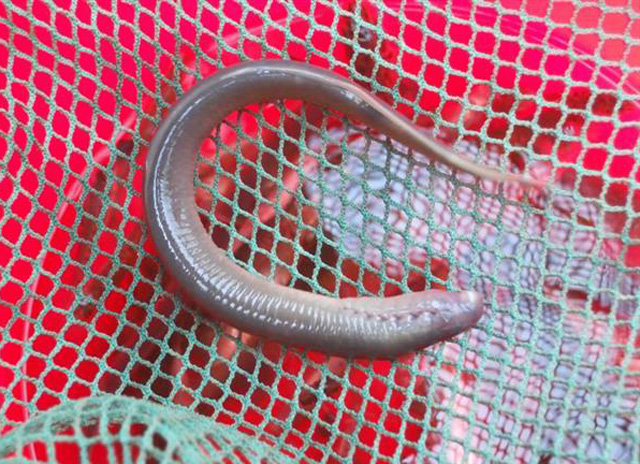| Petromyzontidae (Northern lampreys), subfamily: Lampetrinae |
| 18.9 cm TL (male/unsexed); max.weight: 7.4 g |
|
demersal; freshwater; depth range 0 - 1 m, potamodromous |
| Europe: Endemic to Greece. Known from three creeks in the Struma drainage. |
|
Dorsal spines (total): 0-0; Dorsal soft rays (total): 0-0; Anal spines: 0-0; Anal soft rays: 0-0. Adults: 9.55-15.85 cm TL. Body proportions, as percentage of TL (based on 66 specimens measuring 9.55-15.85 cm TL): prebranchial length, 8.4-13.1; branchial length, 9.5-12.4; trunk length, 46.4-54.7; tail length, 26.2-33.0; cloacal slit length, 0.6-2.0; eye length, 1.3-2.1; disc length, 2.9-7.3; prenostril length, 3.6-7.3; snout length, 4.4-8.9; postocular length, 2.3-3.8. The intestinal diameter, <0.05- 0.10 cm. The urogenital papilla length, as a percentage of branchial length, in eight spawning males measuring 9.6-13.3 cm TL, 3.3-9.1. Trunk myomeres, 53-63. Dentition: All labial teeth are pavement-like; supraoral lamina, 2 teeth, usually unicuspid, but one or both may be bicuspid; infraoral lamina, 7-11 teeth; typically 3 endolateral teeth on each side, but 4 teeth also occur (6 cases out of 96); endolateral formula, typically 2-2-2, but variant formulae occur in 25% of cases and each of the teeth can be either uni-, bi-, or tricuspid; 3-4 rows of anterials; first row of anterials, 4-8 teeth; 2-6 rows of exolaterals on each side; 1-4 rows of posterials; first row of posterials, 10-15 teeth; transverse lingual lamina with a greatly enlarged median tooth but no lateral teeth; longitudinal lingual laminae without teeth. Additonally, 9 of 66 adults possessed 1-2 accessory unicuspid teeth inside the ring formed by the supraoral and infraoral laminae and the endolateral teeth. Velar tentacles, 2-5. Body coloration (preserved) in mature adults is gray on the upper surface and flanks and light brown on the lower surface. Lateral line neuromasts unpigmented. Caudal fin pigmentation, + (2% of specimens), ++ (19%) or +++ (79%). Caudal fin shape, rounded (Ref.89241). Gray to black color of the caudal fins (Ref. 59043). |
| A short-lived, freshwater lamprey which lives in shallow, clear, fairly fast-flowing brooks with gravelly substrate, some rocks and aquatic plants (Ref. 26100). Adults are found at depths of 25-75 cm, in mud, especially among the roots of aquatic vegetation (Ref. 89241). They are filter feeders on microorganisms, including green algae (Ref. 26100). Adults are nonparasitic and believed to live for only 3-4 months. Spawning takes place in December up to May. Ammocoetes larvae live in detritus-rich sands and clay sediments (Ref. 59043). Metamorphosis takes place in December (Ref. 26100); between October and January in the Strymon and Loúros River Basins, Greece (Ref. 89241). Pollution and water obstruction are considered threats to the population (Ref. 26100). |
|
Critically Endangered (CR); Date assessed: 31 January 2006 (B1ab(i,ii,iii,iv,v)+2ab(i,ii,iii,iv,v)) Ref. (130435)
|
| harmless |
Source and more info: www.fishbase.org. For personal, classroom, and other internal use only. Not for publication.

